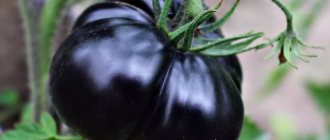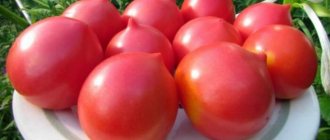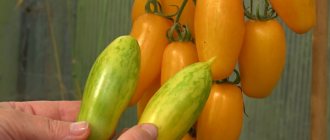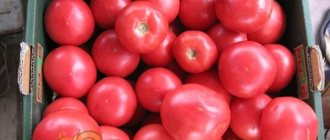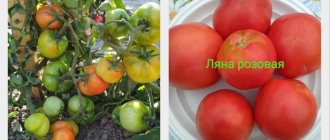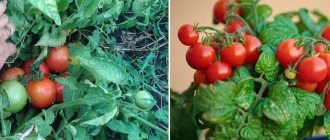Varietal characteristics
Striped chocolate is characterized by tall, powerful bushes of limited growth type. Plant development stops after the formation of 6-8 clusters. The leaf blades are wide, “potato-type”, rich green in color. The inflorescences are simple and begin to appear after the 8th leaf. Each inflorescence bears about 5 fruits.
Characteristics and description of the fruits of the variety
| Fruit weight | 500 grams or more |
| Average yields (with standard agricultural technology) | 8 kg/sq.m |
| Fruit shape | flattened-rounded |
| Color | striped, deep red with chocolate-colored streaks |
| Pulp | dense, low-seeded, rich sweet taste with a characteristic tomato aroma. |
Description of the tomato variety Striped Chocolate
The hybrid variety was introduced by American scientists in the early 2000s and immediately gained popularity in the United States and was among the top three tomatoes at a local festival. The original name of the variety is Chocolate Stripes. In America, farmers grow these tomatoes mainly for sale, because the demand for them is very high. The variety is popular in Europe.
This variety is still not included in the State Register. But thanks to developed Internet technologies and the transfer of information from mouth to mouth, the Striped Chocolate tomato has already won the hearts of our gardeners. Some data in the descriptions of the Striped Chocolate tomato variety varies among summer residents, but in general, enthusiastic reviews about the quality characteristics of the fruit remain stable. Everyone notes the large, unusually beautiful fruits of this tomato variety with a pronounced rich sweet taste.
The tomato is classified as determinate, standard and medium ripeness varieties, but there is also evidence of late ripeness. The end point of growth is areas with 6-8 brushes.
Growing is mainly done in greenhouses, but there are also reviews about growing tomatoes in open ground, albeit in warm climates.
Description of the plant
The bushes are tall, in general there is data on a height of 1.5 m, but there are specimens 1.8-2 m high.
The strong stems have fairly weak foliage, making them easier to grow. These are tomatoes with leaves like potatoes . Indeed, the leaves resemble potato leaves, thick green in color with a very dark tint.
The Striped Chocolate variety has potato-like leaves
Bushes form 1-2 stems . The root system is quite developed.
The inflorescence begins to form above the eighth leaf, each next one after two leaves. Up to five fruits ripen in an inflorescence.
Ripening – 95-120 days.
Description of fruits
The description of the fruit deserves the loudest and most flattering epithets.
- The average weight of tomatoes is 300-500 g , some specimens grow up to 1 kg.
- The shape is irregularly round and slightly flattened.
- The color of ripe fruits is dark red, sometimes with burgundy shades and with dark green veins. Before they ripen, the tomatoes are simply green.
- There are about eight cameras. There are very few seeds.
- The pulp is dark in color, juicy, fleshy, very aromatic, and has a unique sweet taste, so the main use of the tomato with the playful name Chocolate Stripes is certainly fresh.
- Salads with it turn out delicious; cut tomatoes also don’t leak. Tomatoes are very good for sauces and pastes, as long as they don't need to be eaten fresh. These tomatoes are not recommended for whole-fruit canning due to the fact that the skin tends to burst.
Other interesting varieties:
- Persimmon tomatoes: variety description, photos, reviews
- How to Grow Tomatoes Ladies' Man
- Tomatoes Verochka F1: characteristics and description of the variety, cultivation and care
Growing seedlings
Striped chocolate seedlings are sown in the second half of March. Before sowing, the seeds are kept in a pink solution of potassium permanganate for 30 minutes. This treatment prevents the development of fungal and viral diseases.
Sowing is carried out in fairly fertile, light soil. The seeding depth should not exceed 0.5 cm. After germination, the boxes are transferred to a well-lit place with a temperature of 22-25 °C. A higher temperature is not desirable, otherwise the plants will begin to stretch out greatly. 10 days after germination, the seedlings are fed with complex mineral fertilizer. Fertilizer is applied on pre-watered soil strictly at the root.
After the second true leaf appears, the seedlings are planted in spacious boxes or separate containers. After picking, the seedlings are shaded for 2-3 days. A week later, the picked tomatoes are fed with universal fertilizer “For seedlings”. Further care of the seedlings consists of periodic watering and loosening the soil.
Striped chocolate is planted in the ground at the end of May. At the time of planting, the soil should warm up to at least +15 °C. In regions with late spring, film shelters are provided for tomatoes to protect them from return frosts.
Garter and shaping
Immediately after planting, the tomato bushes are tied to stakes. You can also build trellises. This variety has no special formation features. Like most determinate tomatoes, it is grown with 1 or 2 stems:
- in the first case, the fruits grow larger,
- in the second, the size of the tomatoes is smaller, but the yield indicators increase.
In 1 stem
To form one stem on the plants, all lateral stepsons are removed. There is no need to wait for them to grow; plucking is carried out as soon as the stepsons reach a length of 3-4 cm. In total, 3-4 stepsons are carried out over the summer.
Attention! Stepchildren are not completely plucked. When removing them, it is necessary to leave a small stump. This prevents the shoots from re-developing.
In 2 stems
When forming into 2 stems, 1 well-developed stepson is left on the bushes. In the future, it is necessary to remove all side shoots. The left stepson is tied to the trellis in the same way as the main stem.
Productivity
Despite the small size of tomatoes, this variety produces a good harvest. It is achieved due to the large number of fruits on the hands. From a plant you can get up to 3 kg of harvest per season, and from 1 sq. m - up to 9 kg. These are excellent indicators for a determinate variety.
Related article:
Guarantee of an excellent tomato harvest in a greenhouse: 7 varieties for growing in polycarbonate greenhouses
To obtain the declared yield, the plant must be regularly fed and pruned. In this case, it directs all its forces to the formation of tomatoes.
Plant care
During the growing season, tomatoes of this variety must be periodically watered and loosened.
Watering
The amount of watering directly depends on weather conditions. In hot, dry weather, tomatoes are watered weekly. The soil must be wetted at least 40 cm.
Advice! To reduce the amount of watering and weeding, the surface of the soil under the bushes can be mulched with a layer of straw, sawdust, and peat.
Feeding
The application of mineral fertilizers is carried out in 2 stages:
- 10 days after planting in a permanent place, the tomatoes are fed with a solution of urea with potassium humate. Fertilizer application rates can be found on the packaging. It may vary depending on the manufacturer.
- The next feeding is carried out during the budding phase, using potassium monophosphate. If necessary, it can be replaced with other fertilizers of the phosphorus-potassium group: superphosphate, potassium sulfate.
During the growing season, in addition to mineral fertilizers, organic matter can be used. It is especially useful during the development of green mass and at the time of ovary formation. The following can be used as organic fertilizers:
- fermented mullein solution;
- bird droppings;
- fermented infusion of nettle.
The last option is the most accessible, since nettle is present in almost any garden or summer cottage. To prepare the fertilizer, nettles are tightly packed into a barrel or another suitable container. Fill the container to the top with water. When bubbles appear on the surface of the slurry, the fertilizer is ready for use. Before watering, the infusion is diluted in a ratio of 1:10.
Harvesting
Tomatoes are harvested in a slightly unripe state. When fully ripened, the tomato pulp becomes very soft. The fruits of the described variety are excellent for fresh consumption and preparation.
Protection from diseases
Tomato Striped Chocolate can suffer from a number of diseases. Most diseases are a consequence of poor agricultural practices.
A widespread fungal disease. Many nightshade crops suffer from late blight. The pathogen spores overwinter well in the soil and on plant debris. Without treatment, late blight can destroy up to 90% of the entire crop.
How to grow tomatoes
Growing the Striped Chocolate variety is not much different from caring for other tomatoes. It is unpretentious, and any gardener can cope with it. These tomatoes can be grown both in a greenhouse and in open ground. In the northern regions it is better to use the second option.
Transplanting
Before planting seedlings in a permanent place, you need to prepare the soil. Ideally, this is done in the fall.
For 1 sq. m of soil you need to take 0.5 kg of lime, 5 kg of organic fertilizers and 40 g of superphosphate. Dig the soil well before planting.
Advice. You should not grow tomatoes in one place for more than two years in a row. You cannot do this in beds where other nightshades (for example, potatoes or eggplants) grew last year. The best predecessors for this crop are legumes, onions, carrots and cabbage.
Before planting seedlings, you need to dig holes. The distance between rows should be 50 cm, and between plants - 40 cm. The holes are watered in advance.
Seedlings are placed in the prepared recesses. You need to remove it from the containers immediately before planting. The holes with plants are watered with water and filled with soil on top.
Before planting plants in their permanent place, it is worth disinfecting the soil. To do this, just pour it with a weak solution of potassium permanganate, prepared in a ratio of 1:100.
Plant care
Watering is done as the soil dries out. Usually it is enough to moisten the soil 1-2 times a week. The first time watering is carried out 10 days after planting the plants in a permanent place. Take 0.7 liters of water per well.
Hilling is done before watering. It is first done a week after planting tomatoes in the ground. Next, you need to hill up the tomatoes every 20 days.
The first feeding is carried out a week after planting. Organic fertilizers are used for it. The composition can be prepared by taking one part manure to eight parts water. 20 g of superphosphate is added to a bucket of this mixture.
After two weeks, the plants are fed again, but with mineral fertilizers. For 1 sq. m take 10 g of ammonium nitrate, 20 g of superphosphate, 15 g of potassium salt. After another 14 days, the tomatoes are fertilized with the same composition.
Striped chocolate needs garter. Otherwise, heavy fruits will break the bush.
The plant forms one, two or three stems. In the first case, the harvest will appear faster, and in the second and third it will be more abundant.
Pruning is done no more than once a week: all the shoots that appear under the brushes are broken off and the yellow leaves are removed.
Nuances of cultivation
There are several subtleties that not all novice gardeners know about. Taking them into account, you can avoid mistakes and get healthy and productive plants.
Tips for growing tomatoes:
- The most favorable time for watering is evening. On cloudy days, you can moisten the soil at any time.
- Mulching will help protect the plant from pests and diseases. As mulch, you can use straw, hay or special non-woven materials sold in stores.
- Water the plants only with settled water. It is important to pour the liquid only under the root, without touching the greens.
- Stepping should be done in the morning or evening. On the day of this procedure, the plants are not watered.
Diseases and pests
Reviews from gardeners indicate that the Striped Chocolate tomato is resistant to most diseases. He rarely even suffers from late blight, which is the most common cause of crop damage.
To protect the bushes from harmful insects, they can be sprayed with a soap solution. Regular weeding and loosening the soil will prevent damage to the bushes by mole crickets and slugs. Once a week, inspect the bushes and remove pests manually.
Attention! If the plants are covered in spots or their leaves are dry and curled, the problem may lie not in diseases, but in a lack of necessary substances. In this case, make sure that the fertilizing is applied correctly.
Reviews
Please send your reviews and tips on growing tomatoes in the comments, and after checking they will be published on the website.
I grew these tomatoes last year. The bush grew tall and powerful, reaching the ceiling of the greenhouse. The tomatoes are very cute, striped, brown and green. Loved it, delicious!
I bought seeds from Our garden, I didn’t like them, the taste is not very good, maybe it’s a mismatch. I kept it on the bush for a long time and ripened it, still not tasty! And it turned out to be much smaller in size - 40-70 g. There is a lot of pulp.
Girls, every year I plant striped chocolate, I love this variety. It needs to be removed as soon as the skin is colored, then it becomes unpalatable and waddy. This is a feature of all brown varieties.
An excellent variety, beautiful chocolate-colored tomatoes with green stripes, large (250-300 g)! The taste is sweet, juicy, I really liked it! Determinant. I got it late. My favorit!
-Music
—Tags
—Photo album
—unknown
-Always at hand
—Categories
- *** Holidays (265)
- new year (121)
- wedding (40)
- church (26)
- 10% (0)
- *** SPA (336)
- hair (48)
- sets of exercises (43)
- makeup (37)
- legs (15)
- nails, manicure (65)
- perfume and scents (22)
- industrial gymnastics (35)
- hands (2)
- facial exercises (8)
- self care (57)
- *** AUDIO BOOKS (731)
- detective (256)
- historical (65)
- children's (74)
- classic (29)
- memoirs (67)
- book search (27)
- novels (127)
- funny (30)
- fantasy (87)
- ***LAWYER and BUSINESS advice (98)
- *** VIRTUAL TOURS (1852)
- Japan (324)
- public institutions - hospitals, etc. (143)
- Nizhny Novgorod - Gorky (88)
- Poland (32)
- webcams (24)
- the world through the eyes of Russians / foreigners (350)
- museums (154)
- unusual show performances (43)
- 3D - panoramas (212)
- good to know! (102)
- sanatoriums and recreation (21)
- flash mob (22)
- time-lapse photography, time lapse (81)
- excursions (332)
- *** EVERYTHING FOR THE BLOG (489)
- calendars (7)
- funny flash drives (57)
- info on diary settings (37)
- informers (15)
- Google map (4)
- buttons and formulas (39)
- translator (9)
- dividers (33)
- frames (73)
- diagrams and avatars (107)
- table (8)
- text (20)
- backgrounds (12)
- watch (23)
- *** FOR CHILDREN (681)
- poems, songs, riddles (109)
- school (54)
- games - flash drives (39)
- kaleidoscope (3)
- speech therapist (4)
- experiments and educational games (87)
- puzzles (3)
- DIY crafts (177)
- drawing and coloring (74)
- children's websites (22)
- advice from a psychologist (106)
- *** HOUSE (828)
- 3D programs (5)
- balconies, loggias (13)
- bathroom (35)
- living room (3)
- children's (5)
- repair ideas and mistakes (59)
- beautiful and unusual houses (269)
- kitchen (59)
- hallway (4)
- repair - alteration (45)
- bedroom (22)
- house and plot near the house (88)
- farming (219)
- *** ANIMAL LIFE (253)
- cats (133)
- aquariums (15)
- turtles (6)
- *** HISTORY (1491)
- Russian soldiers (141)
- Asia (99)
- Clothing and life (55)
- Africa (36)
- America (95)
- Europe (397)
- reconstruction of history (117)
- Russia (550)
- *** PICTURES - PHOTO (1068)
- pictures gif (93)
- photos for pleasure (32)
- beautiful places (188)
- beautiful photos (74)
- old photos and videos (226)
- artists (405)
- *** CINEMA HALL (1630)
- detective (157)
- children's (59)
- documentaries (233)
- comedy (218)
- BBC melodramas and other costume dramas (183)
- musical (47)
- cartoons (121)
- about life and love (147)
- by actors (103)
- based on real events (42)
- search filmof-f (18)
- adventure (23)
- dancing (75)
- theater (177)
- TV program (4)
- fantasy (69)
- circus (7)
- *** BOOKS (335)
- online libraries (29)
- *** COMPUTER (148)
- tablet (36)
- *** PERSONAL (85)
- *** MEDICINE (660)
- the world through the eyes of a pensioner/disabled person (40)
- children (37)
- diabetes (51)
- vision (5)
- music and other ways - relaxation (106)
- smoking and alcohol (12)
- medicines and folk remedies (36)
- medical news (40)
- spine (54)
- help yourself (172)
- lose weight! (107)
- *** MAN'S WORLD and politics (636)
- *** MUSIC (595)
- 80 - 90's (52)
- 30 - 50's (35)
- 60 - 70's (11)
- fm - radio and music search (16)
- karaoke (13)
- concerts (31)
- opera (57)
- romances and folk songs (127)
- 2000s (100)
- *** PSYCHOLOGY (721)
- =circle of goodness in nature= (158)
- deir (14)
- man and woman (265)
- NLP (20)
- simoron (69)
- equipment (119)
- eniology (18)
- this is useful to know ! (63)
- *** RELIGION (188)
- saints (39)
- articles and films about faith (81)
- churches and monasteries (54)
- *** RECIPES (1513)
- baked goods - cookies, buns, gingerbreads (96)
- vegetable dishes (84)
- fish and seafood (47)
- alcoholic drinks (96)
- no bake (30)
- soft drinks (53)
- baking - molding and dough (81)
- baked goods - not sweet (131)
- baked goods - sweet (158)
- oven - grill (28)
- desserts and sweets (111)
- jelly, aspic, jellied meat (15)
- preparations for the winter (67)
- cuisines of the world (98)
- pasta, noodles, cereals (16)
- microwave (49)
- multicooker (33)
- meat, poultry (77)
- frying and deep frying (40)
- steamer (1)
- dumplings, dumplings, manti (24)
- spices (12)
- websites, books and magazines on cooking (20)
- salads and snacks (82)
- special menu (70)
- soups (17)
- cheese, cottage cheese, dairy (33)
- baked goods - cakes (68)
- fruit (21)
- bread machine (44)
- ***HANDWORK (1021)
- doll houses (100)
- stained glass (12)
- knitting (319)
- decoupage (16)
- carpet needle (13)
- soap (17)
- drawing (55)
- handicraft corner (132)
- websites and books on handicrafts (12)
- earrings and other jewelry (37)
- slippers (59)
- tildes and other dolls (14)
- take pictures ourselves (33)
- embroidery (169)
- *** GARDENING (284)
- country ideas (18)
- parks and gardens (67)
- websites, books and magazines on gardening (5)
- growing technologies (89)
- flowers in the garden (42)
- *** POEMS (233)
- *** TESTS AND DIVINATIONS (165)
- *** LEARNING LANGUAGES (62)
- learn English (35)
- *** FLOWERS (358)
- botanical gardens and greenhouses (21)
- vertical garden (24)
- pests (7)
- plant catalog (124)
- books and websites about flowers (18)
- orchids (78)
- flower care (42)
- citruses (28)
- *** SEWING (549)
- patterns - for children (82)
- patterns - for women (158)
- patterns - for men (14)
- find your style. (95)
- pillows (9)
- bags (9)
- Size correspondence tables (6)
- sewing technologies (81)
- color wheel: (16)
- sewing for home (56)
- curtains (34)
- *** THIS IS INTERESTING (132)
- *** HUMOR (727)
- jokes (132)
- funny pictures! (209)
- funny video (119)
- funny stories (247)
Lemon-liana
A very interesting variety of liana-shaped tomato is Lemon Liana. Its lashes reach a height of 3 m. And it is not without reason that next to the first name of this variety they put the second one - Wonder of the World. This variety has simply huge clusters, which can contain up to 50 fruits each! The variety is extremely productive and resistant to unfavorable growing conditions. Due to the huge brushes, the variety needs support and garter. Beautiful, lemon-colored tomatoes are very tasty and juicy, ideal for canning and table decoration. The size of the tomatoes is small - 60-100 g. The variety is mid-early, tall. Suitable for growing in open ground, but for its intended purpose it is a greenhouse variety.
Mid-season tomatoes: varieties and description with photos
Mid-ripening tomatoes have a well-developed root system and the bush itself. The best varieties of tomatoes have fruits that are much larger than early ripening ones, and the growing season of the plants is 110-120 days.
Bull's heart
The ripening period reaches 110-115 days. The bushes are tall and strong and need support. The tomatoes are delicate pink in color, have good taste and juicy flesh. Their shape resembles a heart, and their weight is 300-400 g, but can reach 1 kg. Used in making salads and juice.
Bull's heart
Danko
The plant is low, up to 1.5 m in height. It is an industrial variety due to its excellent taste and good yield. Characterized by drought resistance. Ripening occurs after 110-115 days. The fruits are large and red, heart-shaped and weigh 150-200 g.
Danko
De Barao
Tomatoes of the De Barao variety are among the best among garden crops. There are pink, yellow and striped subspecies. Bushes can grow up to 3 m in height, so they need support. The fruits are small and elongated, weighing 60-80 g. They are used for canning, preparations, and preparing salads.
Variety De Barao
MIDAS, aka MEDOC
Slightly smaller bushes of the Midas variety, which we often call Medok for its excellent honey taste. Medoc is also distinguished by its original shape of yellow fruits, more like pears. Looking at the bushes of this variety, it seems that it has more fruits than leaves.
The taste of Medok is very similar to the Honey Spas variety. Only its fruits are yellow-pink, and its shape is rounded and elongated.
Colorful heavyweights
If you want to get heavyweight fruits, plant varieties Sun of Heaven and Golden Sun of America. They have huge fruits weighing more than 400-600 g of bright orange color. The stem of these varieties threatens to break off under the weight of the harvest. Therefore, bushes of these varieties need a trellis and a garter, which makes caring for them somewhat difficult. The fruits of these varieties are consumed in salads and used for juice.
Pink tenderness
If you want to eat pink tomatoes, then plant Pinky Lady or Pinky Rise. These hybrids have large, 200-300 g, even fruits, very beautiful, the same size, pink in color, without a green spot at the stalk. A huge plus of these hybrids is that they do not burst. When ripe, they are suitable for transportation over long distances. However, under the skin they do not have the disgusting white layer of fiber that gives modern hybrids their strength.
The advantage of these varieties is that they are quite resistant to diseases and are affected by late blight at the level of domestic varieties.
Diseases and pests
Tomatoes are susceptible to late blight and fungal diseases. Although the Striped flight is resistant to such diseases, for prevention it is necessary to regularly treat the plants with fungicides and tear off the lower leaves. The first time is sprayed a couple of weeks after the seedlings have rooted in a permanent place, then every 10 days. Among the effective drugs suitable for this variety are Ordan, Quadris. You can also treat the seeds with a manganese solution before planting.
Related article:
Why do tomatoes drop flowers? 5 possible reasons
Another common pest of tomatoes is the Colorado potato beetle. Plants are especially often affected by this pest if there are potato plants nearby. To spray tomatoes against the Colorado potato beetle, it is better to use Confidor Extra.
Black and very sweet
Black tomatoes also have their own flavor. They are usually sweeter than red ones, and their color attracts attention.
The most famous variety is the Black Prince, the fruits of which are quite large, up to 200 g, and not completely black, but with a black tint. The fruits may not look very pleasant, but their taste is so good that almost all gardeners plant them with pleasure.
But if you want to plant real black tomatoes, then plant Black Pear or Creme Brulee. The bushes of these tomatoes are small - up to 100-150 cm. Black Pear has small fruits - only 50-80 g, and Creme Brulee has up to 200-400 g, flat in shape. When fully ripe, all of them acquire a rich brown color. These varieties are distinguished by a high content of vitamin C and carotene. And they are sweeter than regular tomatoes.
The Black Galaxy tomato variety is the brainchild of Seeds Technologies, a company specializing in the production of hybrid vegetables. Black Galaxy was obtained by crossing cultivated varieties with wild tomatoes. The peculiarity of the variety is that the longer the tomato is in the sun, the darker it becomes.
Tomato blondes
White-fruited varieties are very unusual. However, there is no point in planting them for sale - no one will buy them: their appearance is too unmarketable. But lovers of these tomatoes note their good taste and ability to last for a long time. The most famous varieties of white-fruited tomatoes are White Heart and White Miracle.
White tomatoes variety White sugar
information about greens - Swamp, kiwi, Siberian malachite. They are very tasty and look great in salads.
Tomatoes Striped Zebra Rita
Tomatoes – Dark Galaxy – Dark Galaxy
The largest of the tomatoes is purple (blue) in color, and at the same time, the earliest. The taste is like large fleshy tomatoes, very rich. It works well both in open ground and in greenhouses. Indeterminate. Long-term fruiting. Resistant to diseases.
Tomatoes with patterned fruit colors are no less interesting than, for example, white-fruited and black-fruited ones, but for some reason they are not so widely known among gardeners. Until today, I have only met 3 such varieties, and it is them that I will tell you about now.
Tomatoes with patterned fruit coloring
I know from my own experience how difficult it is to resist the temptation to buy and grow all the unusual tomatoes at once. Take your time: first read their characteristics and choose only the varieties that are suitable for you.
Tomato variety “Apple color” The fruits of this variety are completely covered with uneven stripes of a yellow-greenish hue, which gradually (as they ripen) become yellow-orange. It is these unusual intermittent stripes that make Apple tomatoes look like apples.
Fruit size is about 200 g. The variety is semi-determinate (plants reach a height of about 170-190 cm), resistant to adverse weather conditions and major tomato diseases.
The plants are tall (reach 2 m), indeterminate. The inflorescences are compact, 4-7 ovaries are formed on one brush. The fruits, weighing 60-70 g, are oval-ovoid, dense, with bright interpenetrating orange-yellow stripes. The variety is characterized by increased resistance to late blight.
Tomato variety “Firework” Tomatoes “Firework” (selection of the agricultural company “Gisok”) surprise with the unusual color of their fruits.
The variety is intended for cultivation in open ground and under temporary film covers. Early ripening, the fruits begin to ripen already on the 105th day after emergence. Plants of the variety are indeterminate, tall (reach 1.5-1.8 m), very powerful. The ribbed fruits of a rounded-flattened shape are distinguished by a bright red color with a scattering of small yellow stripes, which are very reminiscent of fireworks, for which, in fact, the variety received its name. The weight of the fruit reaches 300-500 g.
Velvet tomatoes
Speaking about unusual tomatoes, it would be unfair not to mention the velvet varieties, the fruits of which are very, very original in both appearance and taste.
Tomato variety “Velvet Dude” Medium ripening variety.
Medium ripening variety. The plants are medium-sized, reaching a height of 1 m. The pubescent, round-flat fruits weighing up to 200 grams are very similar in appearance to peaches, which is why the variety is sometimes called peach-shaped.
Tomato variety “Shaggy Bumblebee ” The variety is intended for cultivation in open ground and under temporary film covers.
Mid-early, standard, determinate plants. The fruits are cylindrical, dense, smooth, pubescent; when unripe they are green (the color is more intense at the base), when mature they are bright red. Fruit weight is about 135 g.
Tomato variety "Blue Spruce" Tomato variety "Blue Spruce" can be called a real miracle of selection and here's why: the red-burgundy surface of the fruit (outwardly very similar to small balls) is completely covered with small, barely noticeable villi - it is they that give the tomatoes a decorative velvety quality .
Not only the fruits (their weight is about 180-200 grams), but also the stem of the plant and even its leaves are covered with delicate pubescence. The variety is late ripening (120-140 days). The plants are tall (reach 2 m), indeterminate; Potato-type leaves, quite large, green-blue in color.
Do you already have velvet tomatoes or patterned tomatoes? Tell us - why are they good?
The best late-ripening tomato varieties
Tomatoes of mid-late and late varieties have a growing season of 120 days from the date of planting in the soil. They are characterized by resistance to unfavorable conditions and bear fruit until frost.
Cosmonaut Volkov
This tomato variety ripens in 117-120 days from planting and is suitable for both greenhouses and open ground. Powerful plants can grow up to 2 m in height; they must be tied to supports. Large tomatoes have a bright red color and weigh 250-300 g. The yield of one bush can reach 6 kg.
Cosmonaut Volkov
Rio grand
It is a universal variety. The bushes are low, up to 1 m, have irregularly shaped fruits, weighing 130. Rio Grand is resistant to many diseases, tolerant of environmental conditions and unpretentious in care.
Rio grand
Date fruit
The mid-late variety got its name due to its date-like fruits. The bright yellow color and unique taste make Date one of the best among tomatoes. The fruits themselves are small, well stored and preserved, weighing up to 20 g, forming clusters of 8-10 pieces.
Date variety
